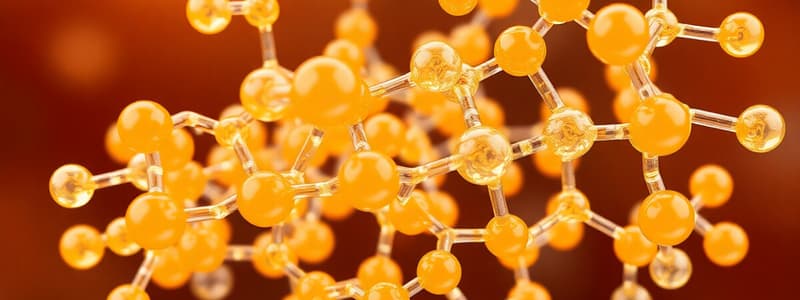Podcast
Questions and Answers
What characterizes glycerophospholipids compared to triacylglycerols?
What characterizes glycerophospholipids compared to triacylglycerols?
- Glycerophospholipids contain one fatty acid.
- Glycerophospholipids have four ester linkages. (correct)
- Glycerophospholipids do not contain a glycerol molecule.
- Glycerophospholipids have only three ester linkages.
Which of the following best describes the ester linkages in glycerophospholipids?
Which of the following best describes the ester linkages in glycerophospholipids?
- They are structural links that exist between the glycerol and phosphate group. (correct)
- They are similar in number to those found in waxes.
- They are responsible for the charge of the phosphate group.
- They are formed by bonding fatty acids to a carbohydrate.
What products are formed from hydrolysis of glycerophospholipids?
What products are formed from hydrolysis of glycerophospholipids?
- Six products are formed.
- Five products are formed. (correct)
- Four products are formed.
- They do not undergo hydrolysis.
Which amino alcohol is NOT typically attached to the phosphate group in glycerophospholipids?
Which amino alcohol is NOT typically attached to the phosphate group in glycerophospholipids?
What is the charge of the phosphate group in glycerophospholipids?
What is the charge of the phosphate group in glycerophospholipids?
The primary structural difference between glycerophospholipids and triacylglycerols is that glycerophospholipids contain:
The primary structural difference between glycerophospholipids and triacylglycerols is that glycerophospholipids contain:
Which functional groups are present in an aminodialcohol?
Which functional groups are present in an aminodialcohol?
What type of reactions do glycerophospholipids undergo due to the presence of ester linkages?
What type of reactions do glycerophospholipids undergo due to the presence of ester linkages?
What is the total number of ester linkages present in glycerophospholipids?
What is the total number of ester linkages present in glycerophospholipids?
Which of the following is a product of hydrolysis of glycerophospholipids?
Which of the following is a product of hydrolysis of glycerophospholipids?
Which amino alcohol is commonly attached to the phosphate group in glycerophospholipids?
Which amino alcohol is commonly attached to the phosphate group in glycerophospholipids?
What distinguishes glycerophospholipids from triacylglycerols concerning the composition of fatty acids?
What distinguishes glycerophospholipids from triacylglycerols concerning the composition of fatty acids?
Which statement is true regarding the hydrolysis and saponification of glycerophospholipids?
Which statement is true regarding the hydrolysis and saponification of glycerophospholipids?
What is the charge of the phosphate group in glycerophospholipids?
What is the charge of the phosphate group in glycerophospholipids?
What is an essential chemical component of glycerophospholipids that differs from triacylglycerols?
What is an essential chemical component of glycerophospholipids that differs from triacylglycerols?
Which of the following statements about the bond formations in glycerophospholipids is true?
Which of the following statements about the bond formations in glycerophospholipids is true?
Flashcards are hidden until you start studying
Study Notes
Glycerophospholipids
- Glycerophospholipids are a type of lipid composed of two fatty acids, a phosphate group, and an alcohol esterified to the phosphate group, all attached to a glycerol molecule.
- Glycerophospholipids have four ester linkages, compared to three in triacylglycerols.
- Glycerophospholipids undergo hydrolysis and saponification reactions similar to triacylglycerols, but with five reaction products instead of the four from triacylglycerols.
Structure of Glycerophospholipids
- The phosphate group in glycerophospholipids comes from phosphoric acid.
- The alcohol attached to the phosphate group is typically one of three amino alcohols: choline, ethanolamine, or serine.
- Choline is a quaternary ammonium ion.
- Ethanolamine exists in a positive ion form.
- Serine contains two ionic groups, an amino group, and a carboxyl group.
Glycerophospholipids and Amino Alcohols
- Phosphatidylcholines contain choline.
- Phosphatidylethanolamines contain ethanolamine.
- Phosphatidylserines contain serine.
Phosphatidyl Group
- The fatty acid, glycerol, and phosphate portions of a glycerophospholipid structure together constitute a phosphatidyl group.
Glycerophospholipids
- Glycerophospholipids are a type of lipid that consists of a glycerol molecule with two fatty acids and a phosphate group attached.
- They also have an alcohol group attached to the phosphate group.
- All attachments in glycerophospholipids are ester linkages.
- Glycerophospholipids have four ester linkages, compared to three in triacylglycerols.
- Glycerophospholipids undergo hydrolysis and saponification reactions similar to triacylglycerols, but produce five reaction products.
- The phosphate group in glycerophospholipids comes from phosphoric acid.
- The alcohol attached to the phosphate group is usually choline, ethanolamine, or serine.
- Glycerophospholipids with choline, ethanolamine, and serine are called phosphatidylcholines, phosphatidylethanolamines, and phosphatidylserines, respectively.
- The fatty acid, glycerol, and phosphate portions of a glycerophospholipid structure are called a phosphatidyl group.
Studying That Suits You
Use AI to generate personalized quizzes and flashcards to suit your learning preferences.




